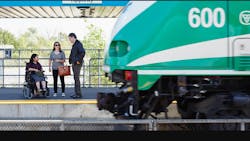Four ways Metrolinx is making transit easier for people with vision loss
Metrolinx’s wayfinding team is taking steps to maximize accessibility on the transit system for all passengers.
Philosophy of Universal Design
When creating navigation and information systems, Metrolinx applies the principles of Universal Design, meaning all customers are treated as equals – instead of singling out people based on their needs. It’s a fundamental condition of good design that reflects the diversity of people who use it and does not impose barriers of any kind.
“We don’t treat the path that a customer in a wheelchair uses as separate from the path that anyone else would take – and equally, we don’t sign it that way,” said Metrolinx Wayfinding Manager Toban Allison.
When it comes to signage, Metrolinx’s rule is to reference the amenity, not the person.
“We always talk about what the amenity is – such as an elevator – making it a little less about a person’s disability and more about the amenity that’s there,” Allison said.
In alignment with this belief, the wayfinding team is currently working on complementing the International Symbol of Access with references to the amenity – such as elevators and ramps – in their signage.
In doing so, the systems are also more inclusive of other people who may need an elevator or ramp – like someone with a stroller or someone using a cane.
“We try to broaden the lens that we use around how we design and sign our facilities, to accommodate a larger group of people – and in doing so, I think we treat everybody in a much more egalitarian fashion,” Allison said.
Bus stop poles with distinct sounds
Metrolinx is working with municipalities throughout the region to implement special bus stop poles that make a distinct sound when tapped, in efforts to accommodate people with vision loss.
Allison explained that the idea came from feedback given by a member of the Metrolinx Accessibility Advisory Committee (AAC), who has vision loss and uses a white cane.
“The challenge they articulated to us is that they struggled to identify which of the many poles their cane touched was the bus stop pole that they should be waiting at,” Allison said. “What we’ve developed as a response is a distinct base, intended to go up on bus stop poles, that is meant to be easily recognizable. If you tap it, it will make a distinct noise.”
The team proposed this solution to the AAC through a dedicated site visit to review this feature as well as new signage in person.
“This allowed us to account for factors that we couldn’t necessarily account for in a meeting room setting,” Allison said. “For example, it was cold and damp, which impacted how long an individual was willing to keep their hands out of their pockets to read a sign.”
In the future, Metrolinx aims to use more digital technologies to make stations more accessible by, for example, implementing audio features on cell phones.
Signage in multiple languages
To make stations more accessible in places where text is needed, Metrolinx will be installing new signage with messages in multiple formats.
“We do raised text in English and French, and braille in English and French, so we provide information in four formats,” Allison said.
The team not only aims to give context about where the customer is, but also what’s on each floor.
“We’re continuing to iterate around this, but it’s going to be super useful. It’s more information than we’ve ever provided for elevators,” Allison added.
However, the team tends to be judicious when implementing features for people with vision loss.
“The reason for that is not because we don’t want to inform those individuals how to navigate a station – but because providing the information in that way is not representative of how they actually experience travel,” Allison said. “In other words, they’re often not feeling the wall trying to find the braille – they have a number of different means of travelling, and we design toward those because those are much more dignified.”
Tactile floor tiles
Instead of focusing only on elements such as braille signs, Metrolinx is working to implement features that may be more practical for people with vision loss.
“We are looking at providing tactile directional wayfinding tiles – which is less about braille and raised text,” Allison said.
An initiative by the Metrolinx Universal Design team, tactile directional wayfinding tiles are made up of a different tiling pattern than the yellow tactile warning tiles used along the edges of higher transit platforms. The wayfinding tiles are installed into the ground surface to facilitate wayfinding in open areas and indicate a direct route that may be taken by cane users.
“We’re trying to make the ideal solution for independent access of people with vision loss. It’s something we’re continuing to work on,” Allison added.
In general, the wayfinding team at Metrolinx is all about advocating for people with disabilities – and never assuming they know the answer.
“If I could emphasize one thing about accessibility and wayfinding at Metrolinx, it’s that we really want to have people with disabilities shape whatever we do,” Allison said. “We want to design in a way that is responsive to their needs, and in the best-case scenario, anticipating their needs. We want to obtain feedback from people with disabilities and involve them in user testing before implementing across all stations. We’ll continue to get better at that, but they’re the drivers of what we do and we’ll just try to keep improving.”
